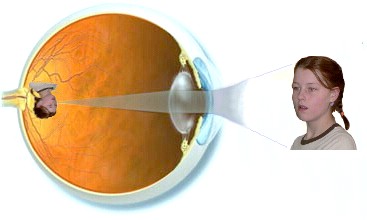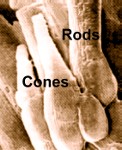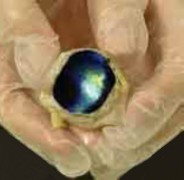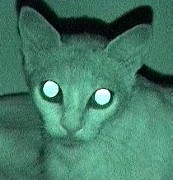 Light entering the eye first passes through the cornea, where it is initially refracted to help it focus on the back of the eye. The amount of light that then enters the eye through the pupil is controlled by the iris, which contracts or expands to let in less or more light.  Now the light passes through the lens. The shape of the lens is controlled by surrounding ciliary muscles, which make it flatter when you focus on distant objects, and rounder when you focus on nearby ones. Both the cornea and lens help to converge light rays so they will focus on the retina at the back of the eye. When the light hits the retina, it causes chemical changes to occur in its photosensitive cells. These chemical changes trigger electrical nerve impulses which are sent, via the optic nerve, to the visual cortex area of the brain. There are two kinds of photosensitive cells lining the retina:  Cone-shaped cells respond to daytime colour, and give us colour vision. (There are actually three types of cones, one type for each of the colours red, green and blue). The fovea contains mostly cones. Rod-shaped cells are much more sensitive to light than cone cells, so they respond to low light levels, giving us some vision in weak light or at night. Rod cells are also more sensitive to motion, so a large number of them line the off-center region of the retina, giving us good peripheral vision. There are two unusual places on the retina. The fovea is the place where the cone cells are most densely packed together, and is mostly responsible for our excellent colour vision; the density of rods and cones here also helps us distinguish small things, such as letters on a page when we read. The optic disk is the place where the optic nerve exits the eye; there are no light-sensitive cells here, so it forms a blind spot. The electrical impulses from the light-sensitive cells on the retina are sent via the optic nerve to the brain. Strangely, your brain receives these signals reversed (left for right, as well as upside down). Your brain sorts out this information and presents you with a correct image of the world. In some animals, the back of the retina contains a reflective layer called the tapetum lucidum which acts like a mirror to increase the amount of light the photosensitive cells can collect. This allows these animals to see better under low-light conditions, such as at dusk or during the night. This is what causes their eyes to glow when they are illuminated by your vehicle's headlights.   |